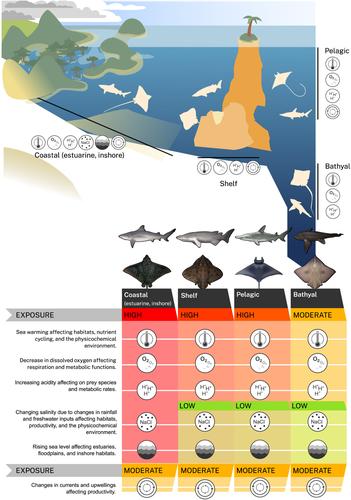当前位置:
X-MOL 学术
›
Glob. Change Biol.
›
论文详情
Our official English website, www.x-mol.net, welcomes your
feedback! (Note: you will need to create a separate account there.)
Vulnerability of Eastern Tropical Pacific chondrichthyan fish to climate change
Global Change Biology ( IF 10.8 ) Pub Date : 2024-07-05 , DOI: 10.1111/gcb.17373 Florencia Cerutti-Pereyra 1 , Elizabeth J Drenkard 2 , Mario Espinoza 3, 4 , Brittany Finucci 5 , Felipe Galván-Magaña 6 , Ana Hacohen-Domené 7 , Alexander Hearn 4, 8 , Mauricio E Hoyos-Padilla 4, 9 , James T Ketchum 4, 9 , Paola A Mejía-Falla 10, 11 , Ana V Moya-Serrano 1 , Andres F Navia 11 , Diana A Pazmiño 4, 8 , Deni Ramírez-Macías 12 , Jodie L Rummer 13 , Pelayo Salinas-de-León 1, 14 , Oscar Sosa-Nishizaki 15 , Charles Stock 2 , Andrew Chin 13
Global Change Biology ( IF 10.8 ) Pub Date : 2024-07-05 , DOI: 10.1111/gcb.17373 Florencia Cerutti-Pereyra 1 , Elizabeth J Drenkard 2 , Mario Espinoza 3, 4 , Brittany Finucci 5 , Felipe Galván-Magaña 6 , Ana Hacohen-Domené 7 , Alexander Hearn 4, 8 , Mauricio E Hoyos-Padilla 4, 9 , James T Ketchum 4, 9 , Paola A Mejía-Falla 10, 11 , Ana V Moya-Serrano 1 , Andres F Navia 11 , Diana A Pazmiño 4, 8 , Deni Ramírez-Macías 12 , Jodie L Rummer 13 , Pelayo Salinas-de-León 1, 14 , Oscar Sosa-Nishizaki 15 , Charles Stock 2 , Andrew Chin 13
Affiliation

|
Climate change is an environmental emergency threatening species and ecosystems globally. Oceans have absorbed about 90% of anthropogenic heat and 20%–30% of the carbon emissions, resulting in ocean warming, acidification, deoxygenation, changes in ocean stratification and nutrient availability, and more severe extreme events. Given predictions of further changes, there is a critical need to understand how marine species will be affected. Here, we used an integrated risk assessment framework to evaluate the vulnerability of 132 chondrichthyans in the Eastern Tropical Pacific (ETP) to the impacts of climate change. Taking a precautionary view, we found that almost a quarter (23%) of the ETP chondrichthyan species evaluated were highly vulnerable to climate change, and much of the rest (76%) were moderately vulnerable. Most of the highly vulnerable species are batoids (77%), and a large proportion (90%) are coastal or pelagic species that use coastal habitats as nurseries. Six species of batoids were highly vulnerable in all three components of the assessment (exposure, sensitivity and adaptive capacity). This assessment indicates that coastal species, particularly those relying on inshore nursery areas are the most vulnerable to climate change. Ocean warming, in combination with acidification and potential deoxygenation, will likely have widespread effects on ETP chondrichthyan species, but coastal species may also contend with changes in freshwater inputs, salinity, and sea level rise. This climate‐related vulnerability is compounded by other anthropogenic factors, such as overfishing and habitat degradation already occurring in the region. Mitigating the impacts of climate change on ETP chondrichthyans involves a range of approaches that include addressing habitat degradation, sustainability of exploitation, and species‐specific actions may be required for species at higher risk. The assessment also highlighted the need to further understand climate change's impacts on key ETP habitats and processes and identified knowledge gaps on ETP chondrichthyan species.
中文翻译:

东热带太平洋软骨鱼类对气候变化的脆弱性
气候变化是威胁全球物种和生态系统的环境紧急情况。海洋吸收了约90%的人为热量和20%~30%的碳排放,导致海洋变暖、酸化、脱氧、海洋分层和养分有效性的变化以及更严重的极端事件。鉴于对进一步变化的预测,迫切需要了解海洋物种将如何受到影响。在这里,我们使用综合风险评估框架来评估东热带太平洋 (ETP) 132 种软骨鱼对气候变化影响的脆弱性。采取预防措施,我们发现评估的 ETP 软骨鱼物种中近四分之一 (23%) 是高度容易受到气候变化的影响,其余大部分(76%)适度地易受伤害的。大部分的高度脆弱物种是蝠鲼 (77%),其中很大一部分 (90%) 是利用沿海栖息地作为苗圃的沿海或中上层物种。六种蝠鲼高度在评估的所有三个组成部分(暴露、敏感性和适应能力)中都处于弱势。该评估表明沿海物种,特别是那些依赖近海育苗区的物种最容易受到气候变化的影响。海洋变暖,加上酸化和潜在的脱氧,可能会对 ETP 软骨鱼物种产生广泛影响,但沿海物种也可能面临淡水输入、盐度和海平面上升的变化。这种与气候相关的脆弱性因其他人为因素而变得更加复杂,例如该地区已经发生的过度捕捞和栖息地退化。 减轻气候变化对 ETP 软骨鱼的影响涉及一系列方法,包括解决栖息地退化、可持续开发以及针对高风险物种可能需要采取的特定物种行动。评估还强调需要进一步了解气候变化对主要 ETP 栖息地和过程的影响,并确定了 ETP 软骨鱼类物种的知识差距。
更新日期:2024-07-05
中文翻译:

东热带太平洋软骨鱼类对气候变化的脆弱性
气候变化是威胁全球物种和生态系统的环境紧急情况。海洋吸收了约90%的人为热量和20%~30%的碳排放,导致海洋变暖、酸化、脱氧、海洋分层和养分有效性的变化以及更严重的极端事件。鉴于对进一步变化的预测,迫切需要了解海洋物种将如何受到影响。在这里,我们使用综合风险评估框架来评估东热带太平洋 (ETP) 132 种软骨鱼对气候变化影响的脆弱性。采取预防措施,我们发现评估的 ETP 软骨鱼物种中近四分之一 (23%) 是高度容易受到气候变化的影响,其余大部分(76%)适度地易受伤害的。大部分的高度脆弱物种是蝠鲼 (77%),其中很大一部分 (90%) 是利用沿海栖息地作为苗圃的沿海或中上层物种。六种蝠鲼高度在评估的所有三个组成部分(暴露、敏感性和适应能力)中都处于弱势。该评估表明沿海物种,特别是那些依赖近海育苗区的物种最容易受到气候变化的影响。海洋变暖,加上酸化和潜在的脱氧,可能会对 ETP 软骨鱼物种产生广泛影响,但沿海物种也可能面临淡水输入、盐度和海平面上升的变化。这种与气候相关的脆弱性因其他人为因素而变得更加复杂,例如该地区已经发生的过度捕捞和栖息地退化。 减轻气候变化对 ETP 软骨鱼的影响涉及一系列方法,包括解决栖息地退化、可持续开发以及针对高风险物种可能需要采取的特定物种行动。评估还强调需要进一步了解气候变化对主要 ETP 栖息地和过程的影响,并确定了 ETP 软骨鱼类物种的知识差距。











































 京公网安备 11010802027423号
京公网安备 11010802027423号